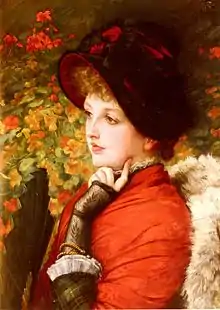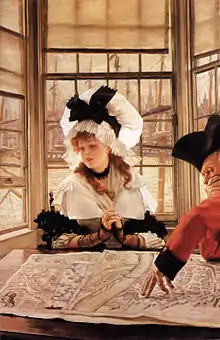Kathleen Newton
Kathleen "Kate" Newton (née Kelly; 1854–1882) was the Irish muse and lover of French artist James Jacques Tissot.

Early life

Kathleen Irene Ashburnham "Kate" Kelly was descended from an Irish Catholic medical family and raised in Agra and Lahore in India.[1]
Her father, Charles Frederick Ashburnham Kelly, an Irish army officer, was employed by the East India Company in Lahore; her mother, Flora Boyd, was from Ireland; and she had two siblings, Frederick W.D. and Mary Pauline.
Around the time of the Sepoy Rising of 1858, her father was transferred to Agra, a city famous for the Taj Mahal, where he rose to the rank of chief adjutant and accountant officer. He retired to London in the 1860s.
When she was sixteen years old, her father arranged for her to be married to Isaac Newton, a surgeon with the Indian Civil Service. On the voyage to be married in India, a fellow passenger, Captain Palliser, became obsessed with her beauty and attempted, unsuccessfully, to seduce her, but was more successful once they had both arrived in Agra. After the marriage in January 1870 and before consummation, she, reportedly upon the advice of a Catholic priest, explained to Isaac the situation regarding the captain.
Newton instituted divorce proceedings and sent her back to England. Palliser paid for her passage, the deal being that in return she would become his mistress. She became pregnant but refused to marry him. Her daughter, Muriel Violet Mary Newton, was born in Yorkshire on 20 December 1871[1] on the same day that her decree nisi came through. The decree absolute for her divorce was granted 20 July 1872.[2] She and her daughter went to live with her married sister Polly's family at Hill Road, St John's Wood.[3][4]
Life with Tissot

Following his involvement in the events of the Paris commune in 1871, French painter Jacques Tissot moved to London, changed his name to James and settled in St John's Wood. In March 1876 Newton gave birth to a son, Cecil George Newton Ashburnham. Tissot is believed to have been the child's father.[1] Newton and her children moved into his home[1] at #17 Grove End Road (now renumbered #44). That same year she appeared for the first time in his painting A Passing Storm, and an etching, titled Ramsgate.[2]
After 1876 Tissot's paintings tended to reflect domestic scenes rather than society life. Newton was 23 when, in 1877, she posed for the painting Mavourneen, a term of endearment derived from the Irish "mo mhuirnín" ("my dear one"), possibly a reference to "Kathleen Mavourneen", a popular song, or the play (based upon the song), which was first staged in London in 1876.[5]
She was called "ravissante Irlandaise" ("the ravishing Irishwoman"), and Tissot was fascinated by the conflict of her Irish Catholic background, divorce and status of unmarried mother of two children. Tissot described their life as "domestic bliss", but she contracted tuberculosis. As Newton's health declined, Tissot's art subtly changed again, reflecting themes of illness or departure.[2] She was unable to watch his grief and overdosed on laudanum, dying in November 1882. Tissot sat by her coffin for four days. She was buried in plot 2903A (register no 043971) in St Mary's Cemetery, Kensal Green.
In popular culture
References
- Isaacs, Deanna. "James Tissot's tragic muse", Chicago Reader (Sun Times), 19 August 2013
- Wood, Christopher. "Newton, Kathleen", Dictionary of Artists' Models, Jill Berk Jimenez (ed.), p. 398, Routledge (2013); ISBN 9781135959142
- "James Tissot's tragic muse". Chicago Reader.
- "James Tissot and Kathleen Newton". my daily art display.
- Murphy, Alexandra. "Mavourneen, Portrait of Kathleen Newton", Sothebys, New York, 24 October 2006
Sources
- Tissot, James Tissot. Victorian Life, Modern Love, Yale Center for British Art (July 1999); ISBN 978-0-930606-89-3
- Wood, C (1986). "Tissot", Scientific London Weidenfeld & Nicolson.
External links
![]() Media related to Kathleen Newton at Wikimedia Commons
Media related to Kathleen Newton at Wikimedia Commons